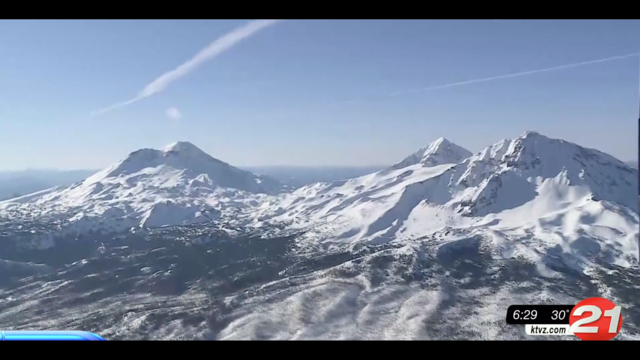
© KTVZ
The Cascade Range may seem quiet, but some of those mountains have a secret: they're still alive. Central Oregon is not only a volcanic region, but also holds the potential for earthquakes.
South Sister is one of many volcanoes in the Cascade Range that's still considered to be alive with activity.
"Many volcanoes in the Cascades are considered active volcanoes, even though they aren't erupting right now," said OSU-Cascades geology instructor Daniele McKay. "They've erupted recently in the geologic past, and since South Sister only erupted 2,000 years ago, which sounds like a long time to us, that's really just yesterday, geologically."
At 50,000 years old, South Sister has been erupting on and off since its formation. It's not an "if" the volcano will erupt again, but "when". The giant stirred in 2001 when an area three miles west of the summit began to rise at a slight rate only detectable by special satellite instruments. This ground uplift is what scientists call "The Bulge".
"For 'the bulge,' it wasn't an awakening -- but it was a tangible example that these volcanoes are in fact active," said Seth Moran, a seismologist with the U.S. Geological Survey. "These volcanoes have erupted every so often, and they are going to erupt again. But it's one thing to have this eruption record that paints a picture every 1,000 years, and it's another thing to have an actual event where there is magma moving up."
Central Oregon is dominated by volcanic byproducts, a unique characteristic of the landscape. The 12-by-6-mile bulge indicates how certain Cascade Range mountains are active, but it doesn't necessarily indicate a potential explosion.
USGS research geologist Dan Dzurisin said any time an area around a volcano is changing shape or deforming, it means something is happening under the surface. Since 2004, the growth rate of the bulge has slowed exponentially."It's not unusual to have deformation at an active volcano system like the Three Sisters," Dzurisin said. "Usually episodes like this don't lead to an eruption, and we don't expect this one will, but we think it's important to keep track of it."
Seismometers keep a close eye on the Cascade Range, including South Sister and Newberry Volcano. Scientists at the USGS Cascades Volcano Observatory in Vancouver, Wash., use this data to monitor ground movement and earthquake activity.
"In the pattern that we see, it tells us that in all likelihood we will have adequate warning," Dzurisin said. "We are expecting to see, before the next eruption, more earthquake activity, more ground deformation, probably more rapid uplift, maybe different kinds of gases coming out of the ground's surface."
It's normal for these events to happen at an active volcano. Moran said about two eruptions happen per century among Washington and Oregon volcanoes -- the most noteworthy of recent time the massive 1980 eruption of Mount St. Helens in southwest Washington. He also said that an active volcano means it will erupt again -- they just don't know when.
Central Oregon is a geologically active region where the potential for volcanic eruptions and earthquakes is real. And each natural process can affect the other.
At some point in the future, the Pacific Northwest should expect a large earthquake with the potential to shake the entire state -- records show the Cascadia 'subduction zone off the coast erupts about every 200 years -- but that does not mean it will cause an immediate volcanic eruption.
"Cascadia, where we live, is an example of a subduction zone, and there are a number of them around the globe, "Dzurisin said. "Plates are colliding and one is being forced under the other in a process we call subduction, and that process produces both very large earthquakes and ultimately leads to the formation of volcanoes."
On a geologic time scale, the extreme earthquakes could cause South Sister or Newberry to explode, but it would be decades or a hundred years after the earthquakes.
For those scientists studying the Pacific Northwest, continuing to expand ou understanding of our mountains' past will help them -- and us -- better understand our future.
"The lesson for the United States in 1980 was that an eruption can happen in the lower 48 and in the West Coast," Moran said. "Before Mount St. Helens I think that was less of a reality -- 'eruptions happen in Hawaii, they happen in Alaska, but not here.' So Mount St. Helens put that to bed."
The Cascade Range is fairly quiet now, but a future eruption is certain. Researchers aren't sure if we will see one in our lifetime. South Sister's bulge is just one reminder that the patient giant is still alive.
If you would like to learn more, you can visit the USGS Cascades Volcano Observatory website at:
Cascades Volcano ObservatoryYou can watch the KTVZ report
here.
Comment: See also: